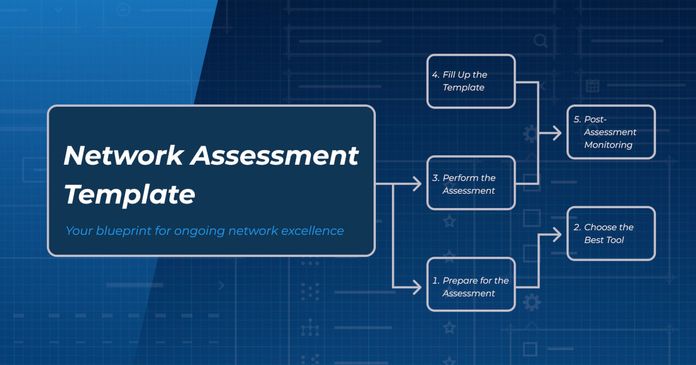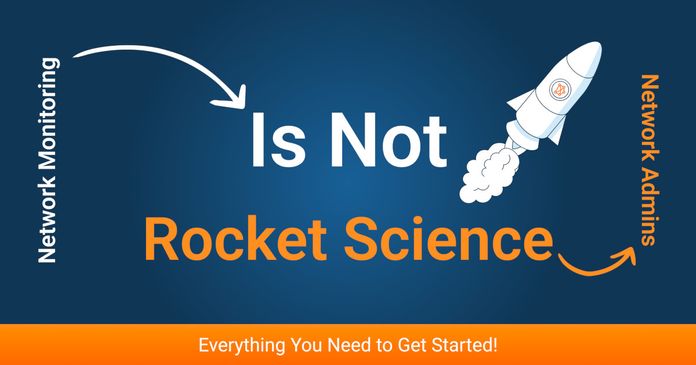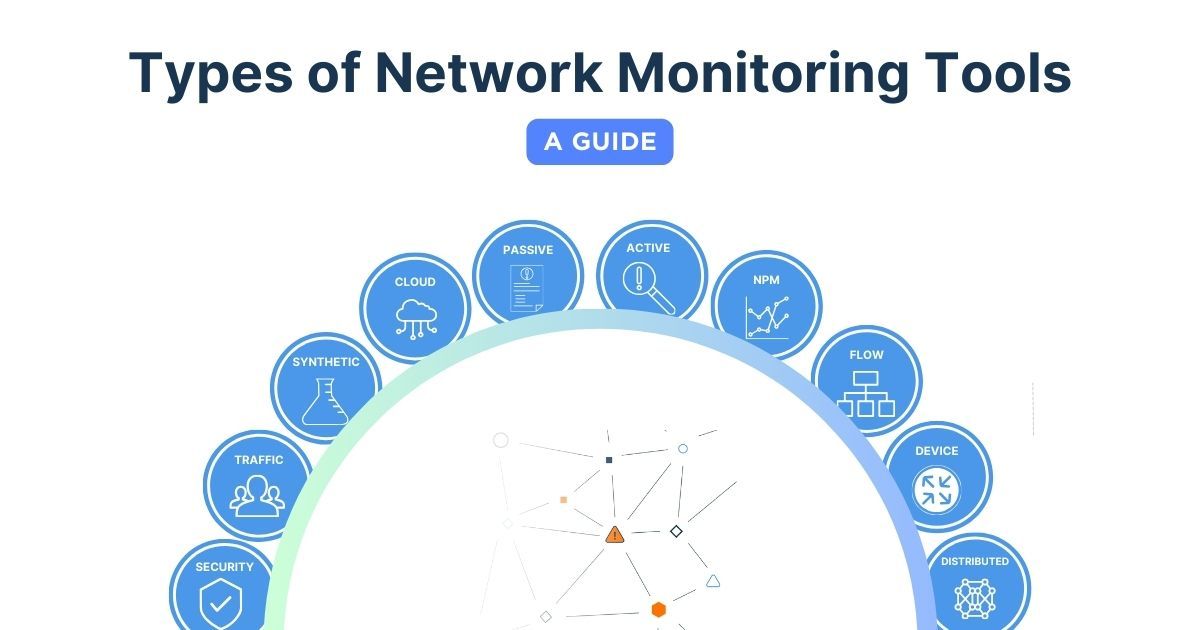Table of Contents
Table of Contents
When was the last time your network threw a surprise party – and by party, we mean a full-blown connectivity catastrophe? If you're thinking, "Not on my watch," well, kudos to you! But here’s the reality check – it's not a matter of 'if' but 'when'.
With more than 30 years of collective experience in the industry, our team knows that network issues come knocking sooner rather than later, and usually when you least expect it. So, how ready are you for the pitfalls hidden in the future? We're not here to spook you, we're here to equip you.
Whether you're an IT professional, a network administrator, or a decision-maker overseeing network management in your organization, you know the stakes: loss of revenue and productivity, delays in order fulfillment, security breaches, poor service delivery and a bunch of frustrated employees trying to figure out the connectivity issues.
Network monitoring isn't just technical jargon; it's the key to achieving seamless business operations, excellent customer experiences, streamlined team workflows, and optimal performance for your network's core applications and services.
Buckle up, because we're about to embark on a ride through the impact of network monitoring on your daily hustle. We'll decode the most popular network monitoring solutions – not just throwing information at you but making it practical, relatable, and actionable. With our checklist, you will analyze your business, ensuring you understand what you need, and not just what you want.
Get ready to uncover the secrets of network monitoring with useful tips and considerations, some "aha" moments, relatable stories, and proof that it's a practical Network Monitoring solutions buyer’s guide tailored for the real world. It's about choosing the right software type that fits your business like a custom-made suit. Yep, consider this your personal tailor for selecting the network monitoring solution that aligns with your unique business needs.
Alright, picture your business as this lively city, right? Employees and customers cruising through its digital streets, just like the roads in a bustling town. Now, think of Network Monitoring (NM) Software as the brains behind the scenes – your traffic control center, managing the data flow with the precision of a well-coordinated team.
In the world of small and medium-sized businesses, it might not be as hectic as a massive metropolis, but smooth operation is just as crucial. Without a proper network monitoring tool, it's like trying to navigate the city without traffic lights – total chaos, bottlenecks, and delays that'll make your head spin.
So, network monitoring tools are your digital traffic lights, making sure the data flow is steady, avoiding data collisions, and quickly dealing with any traffic jams. It's not just about clearing the data lanes, it's like having a GPS for your data, finding the best routes, and making sure every bit of information reaches its destination fast.
Network monitoring, with its variety of metrics, is as crucial for senior managers and business owners as sales figures, directly impacting the financial health of your company.
How?
Gartner revealed a shocking statistic that demands the attention of every decision-maker steering the company: 98% of organizations reveal that the financial toll of just one hour of downtime exceeds $100,000. And, if that's not enough to give you pause, a whopping 81% emphasize that the hourly cost escalates to $300,000 or more.
Now, let's translate these numbers into the language of impact. It's not merely about lost time, it's about bleeding dollars, dropping ROIs, security breaches and data loss. This isn't just a statistic, it's a wake-up call for decision-makers. Taking network monitoring lightly isn't just a gamble, it's walking on the edge of a financial hole. The question isn't whether you can afford to invest in network monitoring tools, it's whether you can afford not to.
Imagine this: with a robust enterprise network monitoring solution in place, your teams are working like a well-oiled machine. No disruptions, no unexpected downtime that sends your profits south. Your operations go smoothly, financial charts look pleasing, projects get done faster and your decision-making becomes sharper than ever.
As indicated by the Digital Enterprise Journal (DEJ), 58% of companies said that it is now a strategic goal to prioritize tracking IT performance from the perspective of users. Furthermore, customer experience is prioritized in IT initiatives by top-performing firms 2.2 times more frequently than other organizations.
Network monitoring isn't a luxury, it's the necessity to move sufficiently from point A to point B. Remember people saying exactly the same thing about cars not that long ago?
Your world revolves around keeping the digital engine running. It's not just about minimizing downtime, it's about network troubleshooting, conducting a thorough network assessment, preventing disruptions and ensuring your services meet customer expectations. You're not there just to keep the lights on, you're the architects of a seamless digital experience for everyone involved. Let's delve into how NM shapes your world:
1. Navigating the Health of Your Network with Audits/Assessments
Anticipating the future is equally as important as the present. Availability, latency, throughput, utilization, and error rate are critical performance metrics that administrators examine in detail to provide a complete picture of the network's health. This is a strategic roadmap, not just facts. Before making a big service deployment or migration, such as switching from MPLS to SD-WAN or SASE, or implementing VoIP and UC, picture yourself having a thorough network assessment. It's about preemptive insights that steer you away from potential pitfalls.
2. Solve the Mysteries of Network Problems through Troubleshooting
Through real-time analysis of factors such as latency, throughput, and packet loss, it turns network troubleshooting from a mystery into a simplified procedure. Imagine having immediate access to the location of the issue, whether it is on the LAN or WAN, exact timestamps of when it happened, forensic knowledge of the cause, and a clear understanding of who is responsible for fixing it. It's not only about finding problems, it's also about speeding up your response time when issues arise.
3. Real-Time Network Monitoring for Peak Performance
Real-time visibility is essential in your daily routine when it comes to VoIP quality, Unified Communication Applications (like Zoom and Microsoft Teams), SD-WAN Networks, MPLS Networks, Cloud Applications, and more. It's about creating a seamless user experience, not just about avoiding downtime. Constant observation serves as your surveillance, identifying and evaluating problems before they develop into major issues. It is the foundation of a network's health, making sure all of its parts, from WiFi and the Internet to SaaS apps and network devices, are operating at maximum capacity.
Real-life use-case:
With over 50 retail locations and a customer base exceeding 135,000, VPharma's IT team faced collaboration challenges with Level 1 technical support from their service providers. Network performance problems, including issues with the POS system, led to frustration among frontline employees who were consistently dealing with network disruptions impacting customer experiences.
Executives quickly realized that they needed a solution that:
- Could be managed remotely and was not too complex for their small IT team
- Allows for fast issue resolution and proactive troubleshooting
- Mitigates employees’ frustrations as well as negative customer experiences in stores
Soon enough Vincent Raze, IT Director at VPharma, realized that Obkio had all the functionalities they needed.
As of today, network administrators at VPharma have the necessary performance visibility throughout all their locations to identify and start fixing their network problems before users do.
Read more about VPharma End-User Network Monitoring for Retail Stores in a case study on our website.
Learn how Obkio works with retail pharmacy, VPharma, to provide a solution for end-user network monitoring and troubleshooting in distributed retail stores.
Learn more

Now, let's take our previous analogy a step further. Consider the possibility of network brownouts – a situation where the roads are not just congested but completely blocked, bringing the entire city to a standstill. Notably, Internet brownouts or network brownouts rank as the 3rd most critical challenge faced by every IT organization, coming right after outages and security breaches.
In the digital landscape of your business, network burnout is similar to a complete breakdown of communication. It's like every road in your city suddenly closing, preventing both employees and customers from reaching their destinations. This is where Network Monitoring Software becomes your digital emergency response team.
In a recent study conducted among American businesses, over 60% of network brownouts are initially identified by customers and employees or go unreported, rather than being proactively detected by IT organizations.
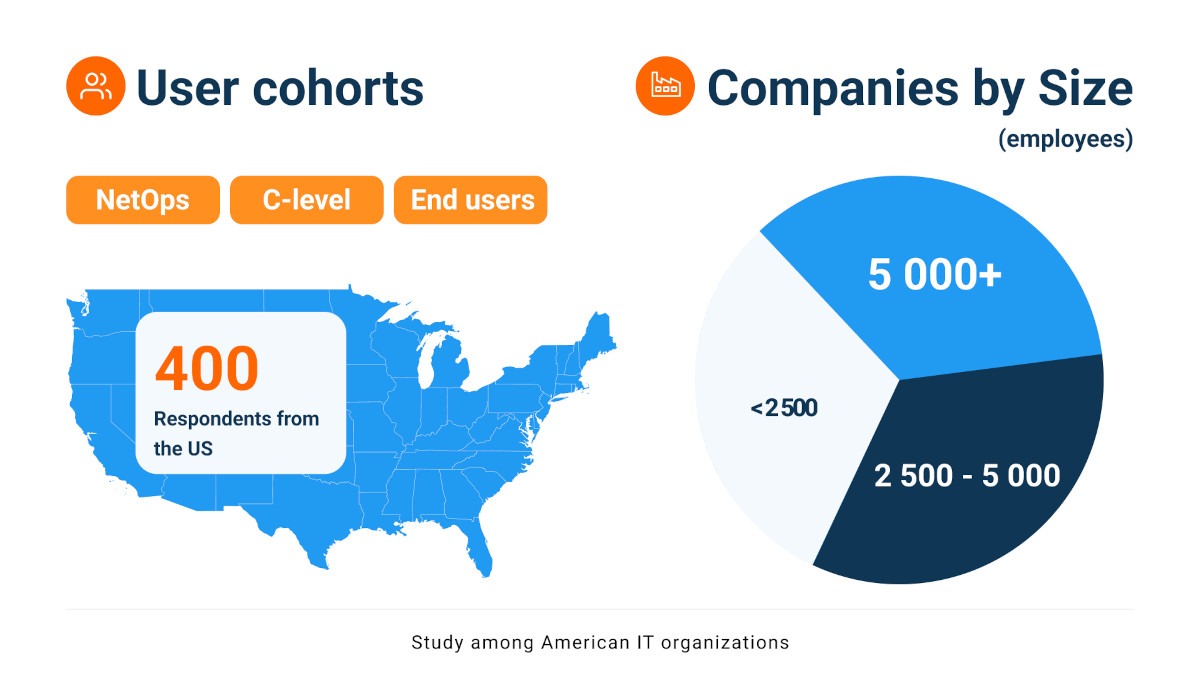
Acknowledging the pivotal role of their network in business operations, 90% of enterprises prioritize its significance. However, it's concerning that a substantial 61% of Network Bottlenecks slip under the radar, escaping detection by IT/NetOps. This oversight not only poses potential risks but also emphasizes the critical need for robust enterprise network monitoring tools.

As you can see now, if these declines in network performance are not addressed, there may be serious and expensive impacts. Fortunately, businesses can be equipped to deal with these kinds of circumstances, and network monitoring software is essential to this proactive strategy.
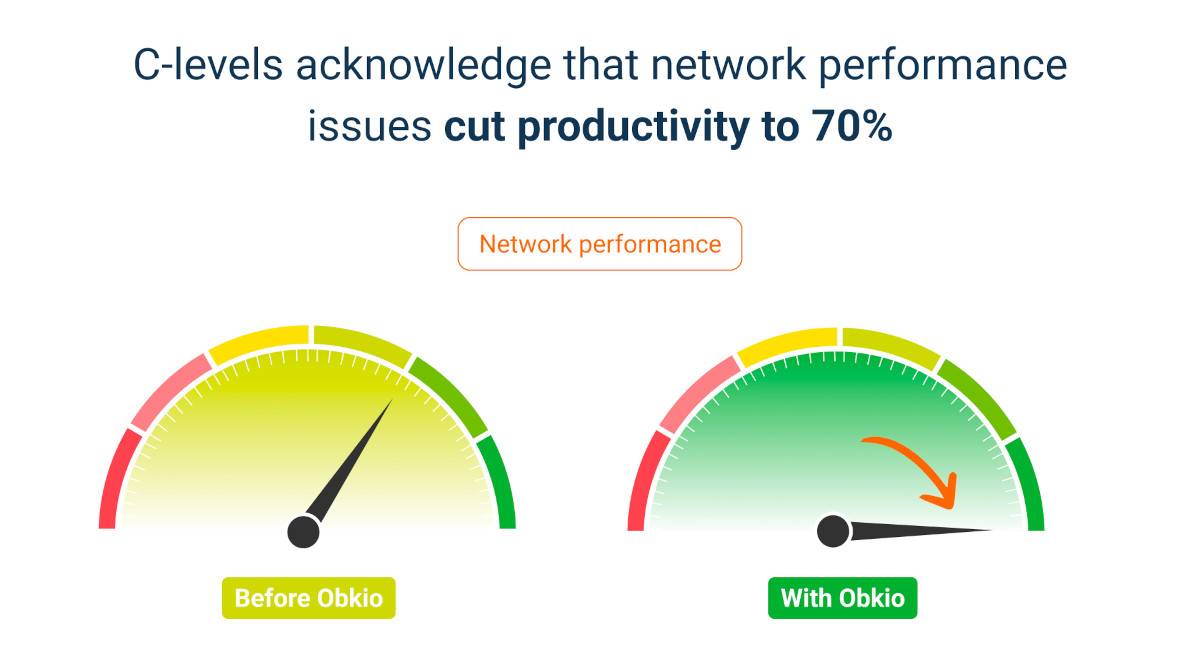
Obkio provides a strong network monitoring solution that is easy to use and comprehensive for companies of all sizes in a variety of industries, such as professional services, manufacturing, banking, and more. Several network monitoring features are available on our platform to assist customers in promptly identifying, diagnosing and fixing network problems before they have an effect on end users.
These include active monitoring agents generating synthetic traffic, network path monitoring, cloud network monitoring, guaranteeing uninterrupted connectivity for all workers, efficient operation of crucial apps, and much more.
With an easy-to-use interface that requires little training and a straightforward setup procedure, it makes Obkio both simple to deploy and operate.

Sounds like an easy choice for you? Cease the search for a Network Monitoring tool now.
- 14-day free trial of all premium features
- Deploy in just 10 minutes
- Monitor performance in all key network locations
- Measure real-time network metrics
- Identify and troubleshoot live network problems

Welcome to the core of our journey - understanding the beating heart of your business. We're not diving into tech specs just yet, we're stripping it down to the essentials. Think of it as the business health check before diving into the world of network monitoring solutions.
Let's conduct a deep dive into the crucial elements that will tailor your network monitoring solution to your business's unique requirements.
1. Current Network Infrastructure
Take inventory of your existing network architecture. What devices, servers, and connections compose your digital landscape? Evaluate the complexity and scale of your network – it's the first step towards understanding the terrain.
Example: Imagine a managed service provider (MSP) dealing with an intricate network of interconnected servers, devices, and cloud services supporting multiple clients. Assessing the current network infrastructure is akin to creating a detailed map of this complex digital landscape.
Unlock the power of network assessment with our step-by-step network assessment template. Follow this ultimate blueprint for ongoing network excellence.
Learn more

2. Business Operations and Growth Plans
Analyze your current business operations and project them into the future. How will your network support growth? Consider essential monitoring features for scalability, ensuring your network aligns with your business's evolutionary path.
Example: MSP overseeing a client's VoIP and UC services must project how network growth aligns with the client's expansion plans. An ISP supporting a growing number of remote connections anticipates increased bandwidth requirements. This foresight ensures that the network infrastructure can smoothly accommodate increased communication demands.
3. Recognizing Specifics of Your Industry
Acknowledge the unique requirements and challenges of your industry. Industries may have specific compliance standards, security concerns, or performance benchmarks influencing the choice of network monitoring tools. \
Example: In the financial sector, MSPs dealing with WAN and LAN connections must consider strict compliance regulations. A network monitoring solution tailored to financial industry standards becomes critical for seamless operations.
4. Defining Budget Constraints
Clearly define a budget for network monitoring solutions, encompassing both initial costs and ongoing expenses. Seek solutions that offer value without compromising critical features. Carefully navigating budget constraints ensures a cost-effective yet robust solution.
5. User Experience Expectations
Identify the desired user experience. Understand how network performance contributes to user satisfaction and productivity across various services. An MSP catering to end-users reliant on cloud-based services must prioritize user experience. Enterprise network monitoring ensures these services operate optimally, contributing to overall user satisfaction.
6. Navigating Your Team's Technical Terrain
Understanding the technical expertise of your team is a pivotal compass point in your network monitoring journey.
Tip: If your team possesses a high level of expertise, a solution with robust documentation becomes invaluable, empowering admins to troubleshoot and optimize without constant external support. On the flip side, for teams expecting regular challenges, opting for a solution with responsive 24/7 support ensures swift issue resolution, maintaining operational excellence and client satisfaction.
Think of these criteria as a checkup for your network's well-being. Identify the pain points, anticipate growth-related challenges, and envision the user experience you want to deliver. It's not about what's popular, it's about what fits your business like a glove.

- Is there a clear network performance goal for my business?
Define performance goals to tailor your monitoring approach and stay ahead of trends or common issues. Flexibility is key, adjust goals periodically for evolving needs.
- Are network issues a challenge?
Network monitoring simplifies the detection of network issues with visual displays, allowing you to gain visibility into the performance of network devices, applications, services and more to collect critical data, and enhance troubleshooting efficiency.
- Does your organization worry about network security?
Sudden metric changes can flag potential threats. Integrating monitoring with security solutions offers a comprehensive view, ensuring your network stays fortified.
- What in your network do you need to monitor?
In general, an end-to-end network monitoring approach is always the best so you don't miss any blindspots. However, you can choose to deploy a network monitoring solution in only specific areas that matter most. Identify what parts of your network support your most important applications or services, or are most prone to network bottlenecks.
- How straightforward is the setup?
A quality network monitoring tool should deploy seamlessly. Avoid complex setups or resource-draining options of traditional enterprise network monitoring solutions with features your business may not even need If it feels like a drain on vital resources, explore other solutions.
- Does your solution deliver actionable network monitoring alerts?
Alerts should be more than just notifications, they should offer insights—what, where, when. Tiered and timed alerts refine the focus, ensuring you're aware of critical issues promptly.
- How does pricing align with value?
Pricing tiers, while important, shouldn't overshadow effectiveness. Balance cost and features for a solution that truly meets your needs.
- Can you monitor from anywhere?
Remote access is non-negotiable. Ensure your team can manage and monitor the network regardless of their physical location.
- Can the network monitoring solution grow with your network?
Opt for scalability to accommodate growth and flexibility to adapt to changing network landscapes. Disable monitoring where unnecessary, keeping your focus sharp.
- Is the solution easy to navigate?
Opt for a user-friendly structure that simplifies navigation. An intuitive network monitoring dashboard design ensures easy operation, reducing the learning curve for your team and enhancing overall productivity.
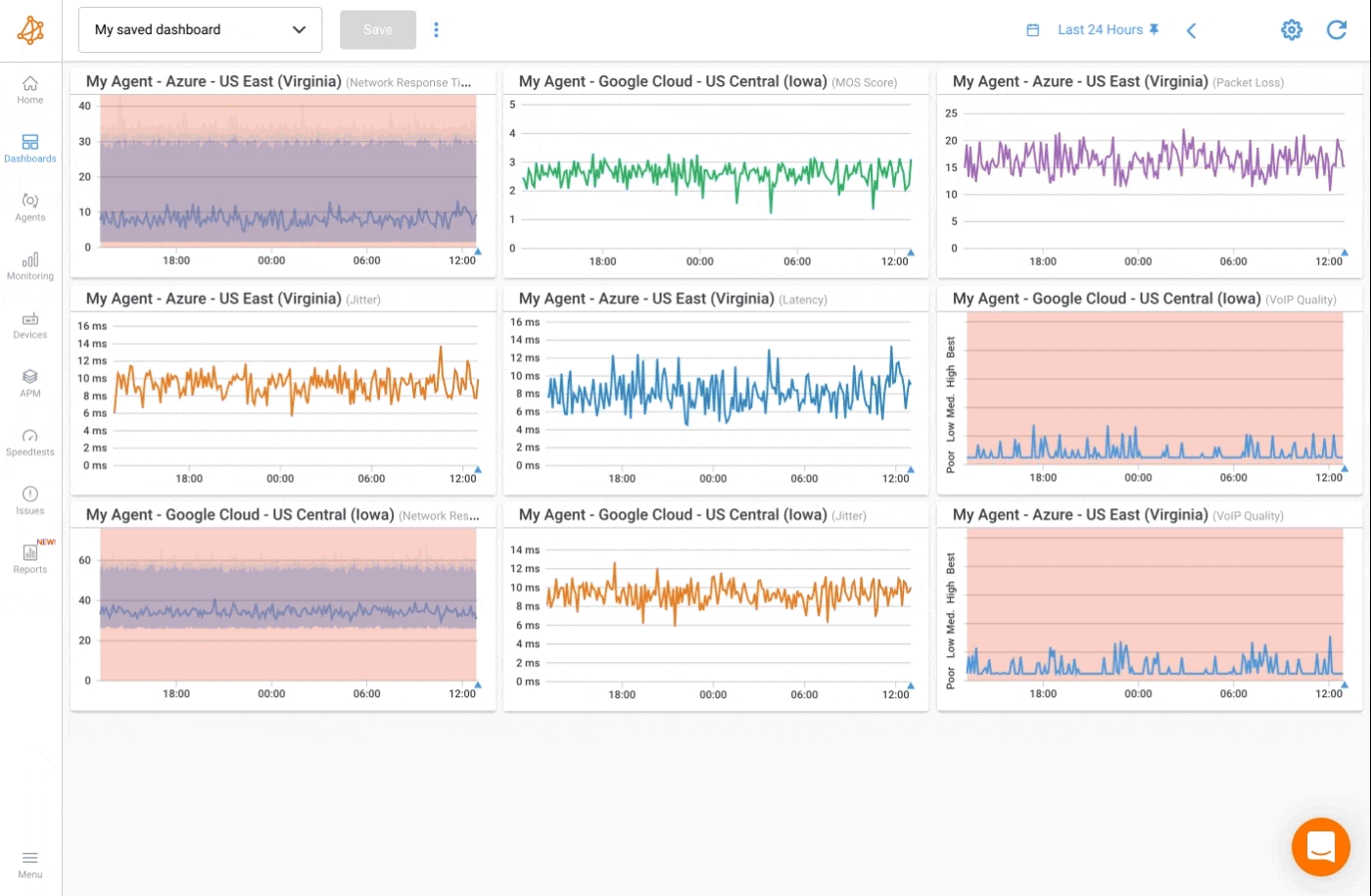
Network monitoring companies are as diverse as the challenges they aim to address. They vary not only in their intended purpose but also in feature offerings, scalability, integration capabilities, and deployment methods. It's crucial to recognize that what works seamlessly for one organization might not be the ideal fit for another.
Some tools boast all-in-one brilliance, providing a comprehensive solution within a single platform, which may be too loaded with features for smaller and medium-sized firms. Others take a modular approach, allowing you to pick and choose functionalities based on your specific needs. Understanding your business requirements is key to determining which network monitoring company to partner with.
The selected tool can significantly impact the efficiency, productivity, and overall success of your business. It's not just a technical choice, it's a strategic decision that influences the seamless operation of your business.
There are many different types of network monitoring tools, but we’ve outlined the four main categories in this guide to help you quickly navigate to your perfect fit. Each category comes with its own set of advantages and disadvantages. By understanding these distinctions, you'll be better equipped to make an informed decision tailored to your unique business needs.
Ready to explore the options?
These solutions take a specialized approach, standing out in the realm of IT management platforms. Pure enterprise network monitoring tools are specifically designed for the sole purpose of overseeing, controlling, and sustaining the performance, accessibility, and overall health of networks.
The software is usually developed and maintained by a team of experts. Due to their extensive knowledge of the network management industry and ready access to resources, these companies are able to provide dependable products that MSPs can rely on for network performance, user experience and MSP monitoring.
Common Value Proposition from Vendors:
- Monitor and analyze various network devices (servers, routers, switches, firewalls, and other hardware components);
- Collect and analyze the data & network parameters (response times, bandwidth utilization, error rates, etc.);
- Identify potential issues, bottlenecks, or outages;
- Real-time notifications and network monitoring alerts;
- Detect performance issues or security threats, facilitating rapid troubleshooting and resolution.
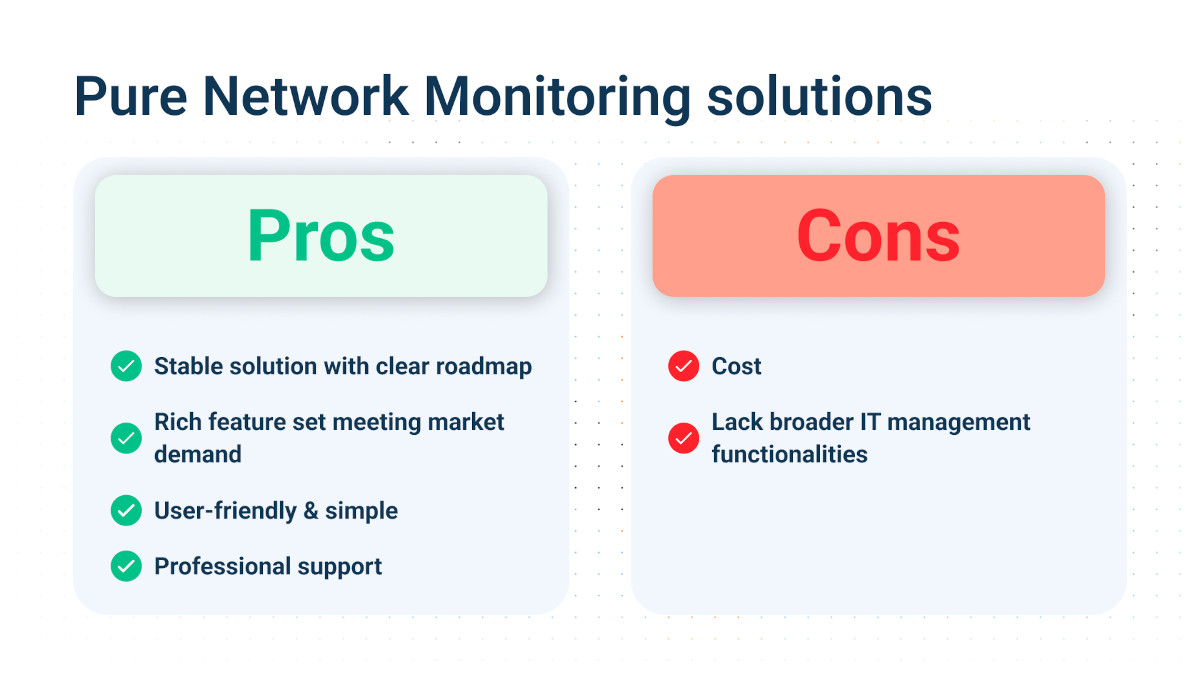
Considerations:
While customer support is frequently offered by network monitoring companies to help with software-related problems, it's vital to remember that not all businesses place a high value on the calibre of their support offerings.
Obkio was designed to simplify network monitoring, by continuously monitoring end-to-end network performance from the end-user point of view to offer advanced analytics, and complete visibility with customized dashboards, smart notifications, thresholds, and reports. The software is not a one-size-fits-all solution but is uniquely designed by a dedicated team of experts who specialize in the nuances of enterprise network monitoring.
We specialize in providing a client-centric solution with a plug-and-play setup, ensuring ease of use, swift deployment, and an intuitive design. This user-friendly approach makes it accessible to a wide range of users, from IT professionals to decision-makers.
Our professional support is one of the things that sets Obkio apart. We are known for prompt and dependable service validated by the positive feedback from our customers who have experienced firsthand the assistance provided by our team.

With a growing team of professional engineers who work day-in and day-out on improving our platform ensuring it meets constantly evolving market demands, you can be assured that Obkio stays up to date and will not become stagnant or outdated over time.
Our network monitoring platform can help with a variety of tasks, including troubleshooting network problems, guaranteeing uninterrupted connectivity for distant workers, and monitoring crucial operations.
Here’s how you can take network monitoring to the next level.
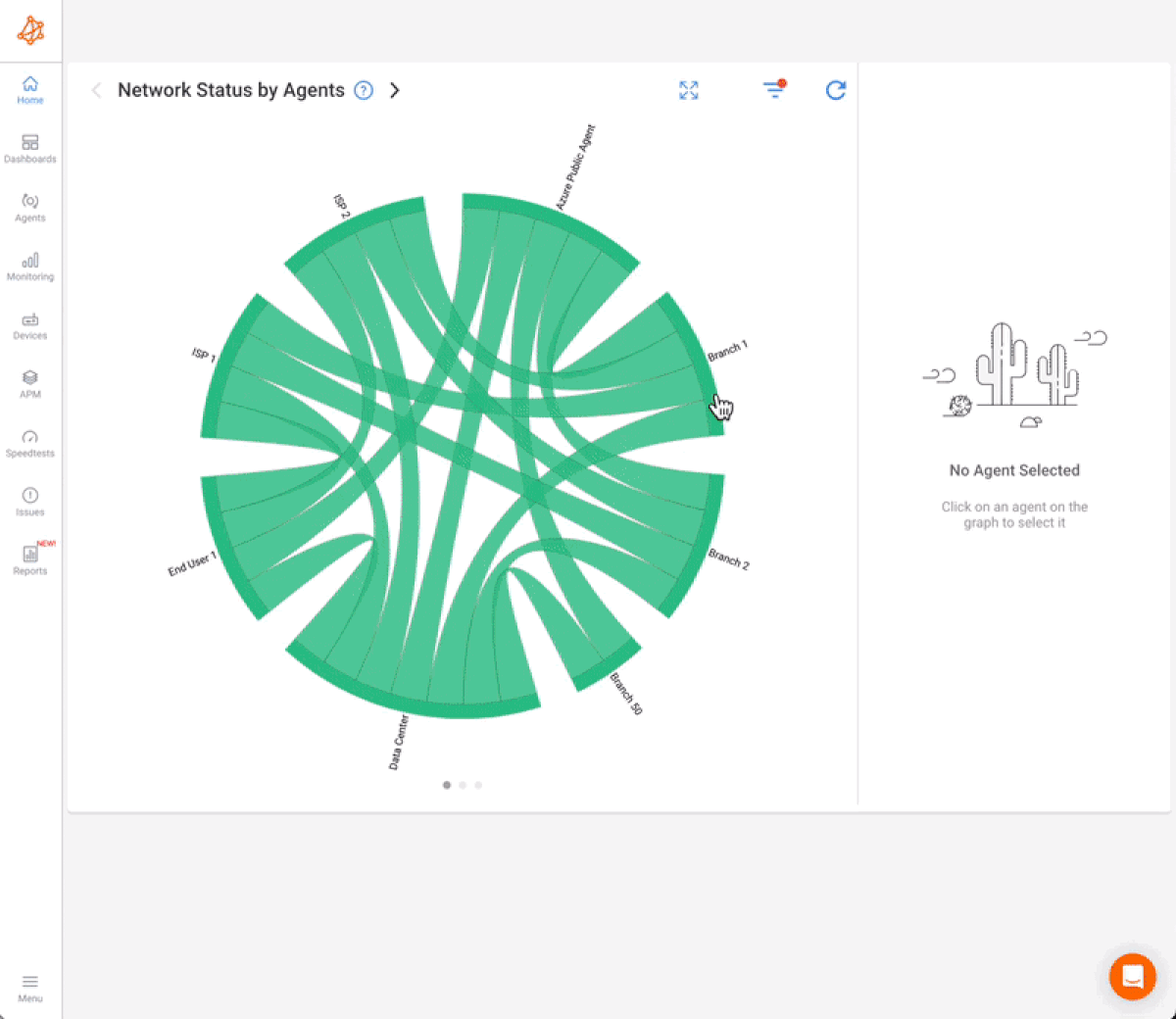

All-in-one enterprise network monitoring software excels in managing the performance of intricate IT environments across multiple layers. While their primary focus extends beyond just network management, these platforms offer advanced features for monitoring, troubleshooting, and optimizing infrastructure and application performance.
Common Value Proposition from Vendors:
- Monitor and analyze the performance of diverse IT components, including networks, servers, applications, and cloud services.
- Identify bottlenecks and inefficiencies to optimize both infrastructure and application performance.
- Diagnose and troubleshoot issues swiftly with advanced tools and analytics.
- Facilitate seamless integrations with other tools and systems through well-documented APIs.
- Scale effortlessly to accommodate the growing complexity and size of IT environments.
- Support collaboration among teams by providing features for shared monitoring and issue resolution as well as a bunch of other additional tools.
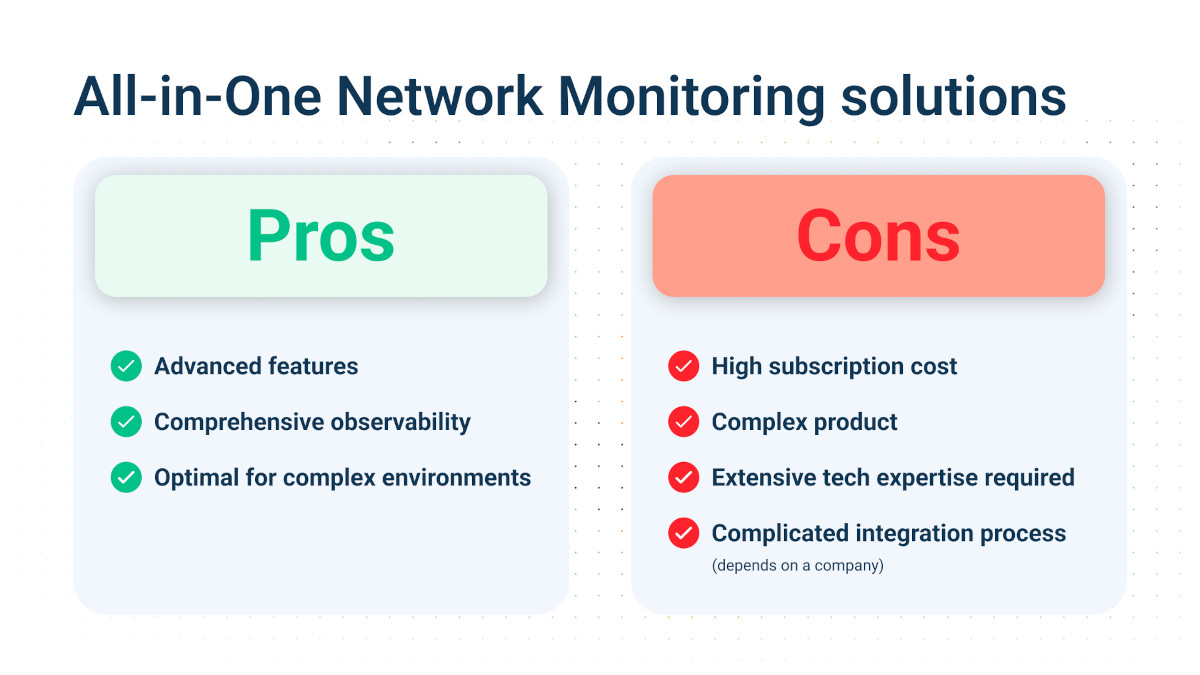
Considerations:
Through APIs and add-ons, these network monitoring companies frequently facilitate smooth integrations, enhancing productivity, client satisfaction, and operations.
However, such products can be complex, and the rich feature set may be extensive for smaller MSPs. Technical expertise from your team may be required for optimal use.
Open-source network monitoring tools are cost-effective and efficient, delivering the agility needed for network performance. They're like the sports cars in a race where speed and flexibility are paramount.
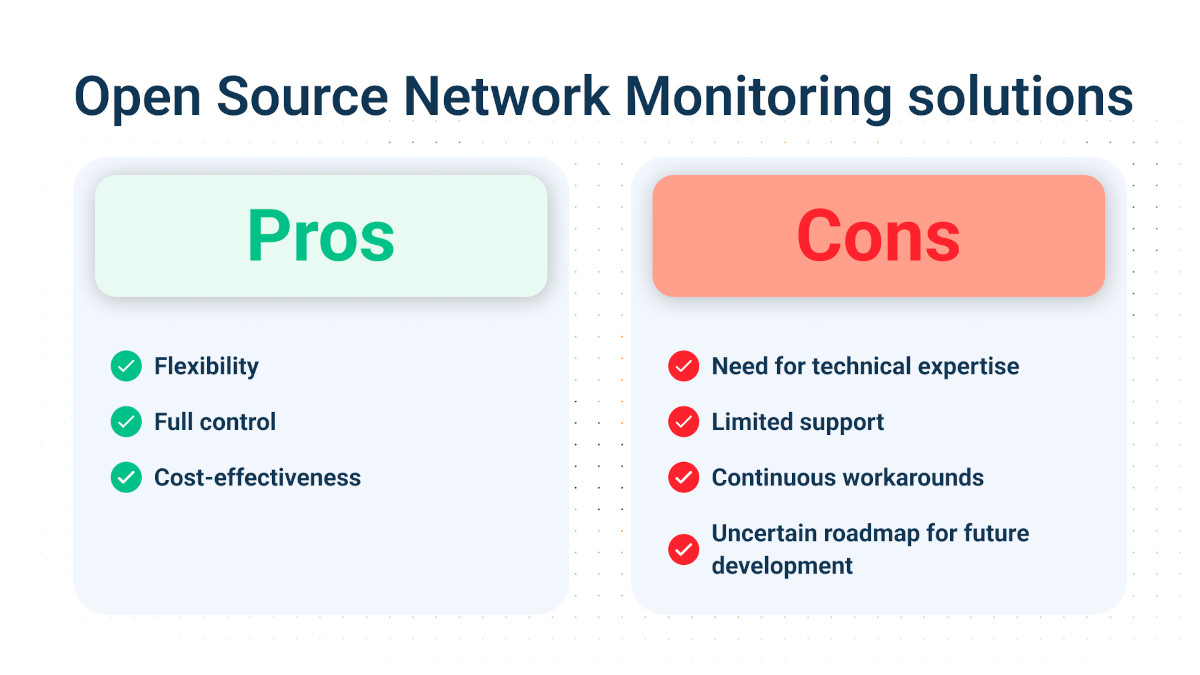
Common Value Proposition from Vendors:
- Open-source translates to cost savings, making these solutions particularly appealing for organizations with budget constraints.
- Leverage the power of a community-driven approach, benefiting from continuous improvements and contributions from a diverse user base.
- Tailor the monitoring setup to your specific needs with extensive customization options.
- Enjoy compatibility with a wide range of network protocols for comprehensive monitoring.
Considerations:
It's crucial to remember that open-source network monitoring software can often provide difficulties due to intricate workflows that call for a great deal of manual configuration, hence you’ll need technical expertise in your team.
Because these solutions are dependent on contributions from the community, you can have trouble getting quick technical support when problems arise.
Packet capture-based technologies emerge as the powerhouse for high-level IT security network monitoring tools. Specializing in granular data analysis and threat detection, these solutions capture and scrutinize network traffic with unparalleled precision.
Common Value Proposition from Vendors:
- Packet analyzers seize network packets through real-time monitoring of network interfaces or reading packet capture files.
- See insights into protocol usage, identify abnormalities, and pinpoint protocol-specific issues.
- Monitor network traffic patterns, reveal bandwidth usage, and detect bottlenecks. Administrators can inspect packet-level details, identify errors, diagnose problems, and determine the source of network-related issues.
- Detect unauthorized access attempts, analyze packet payloads for potential threats, and support network intrusion detection and prevention.
- Optimize network performance by identifying inefficient or misconfigured network devices, diagnosing latency issues, and offering insights into network traffic patterns.
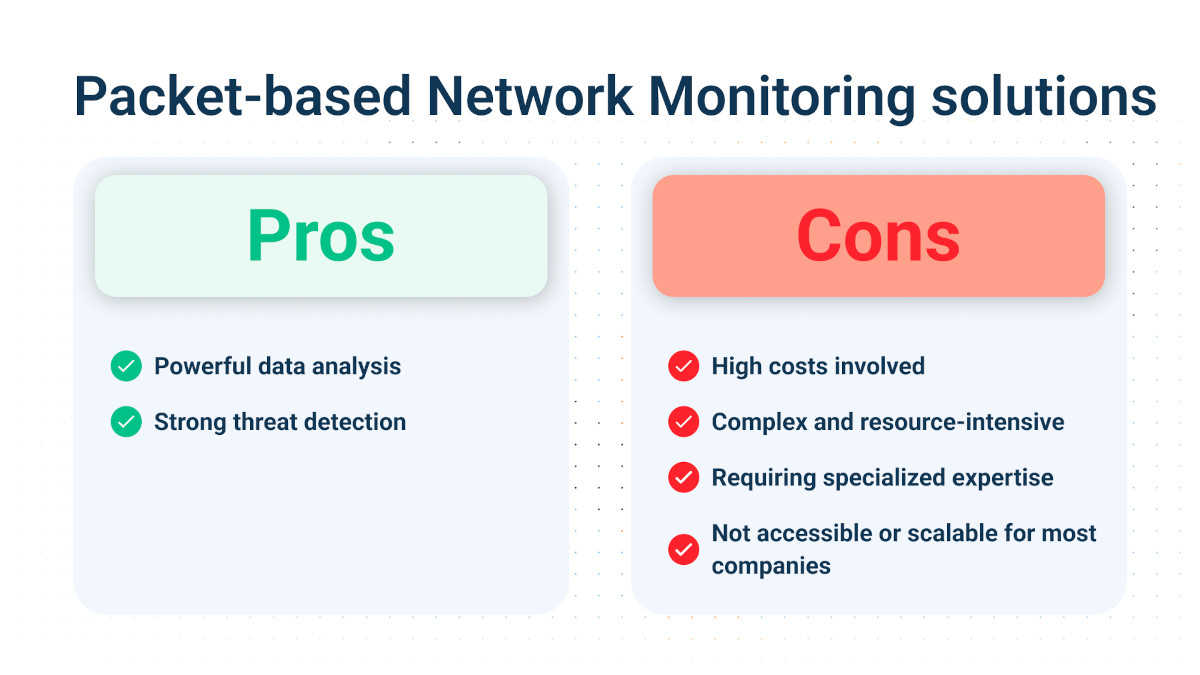
Considerations:
Packet-based methods can be resource-intensive, requiring substantial hardware resources for data collection and storage. Additionally, they may demand specialized knowledge for effective data processing.
The resource demands and complexity may pose challenges for businesses aiming to scale their network monitoring capabilities, particularly for smaller organizations with limited resources.
When choosing a network monitoring company, begin by selecting 3 to 5 vendors that appear to fit your requirements. Get quotes, complete proposals, and prices from those providers.
Seek a solution that will allow you to rapidly get started and bear the least amount of implementation costs so that you may develop a working prototype. By taking this method, you will be able to test the software and different situations to determine whether it genuinely satisfies your demands and has the capacity to expand with your organization.
As you finalize selecting an enterprise network monitoring tool, these considerations serve as last checks before pressing the launch button.
Network monitoring techniques can be categorized into active, passive, and flow-based methods. Let’s take a quick look into each of them:
Passive network monitoring tools observe and analyze existing traffic, providing valuable insights into network health and usage patterns. They capture real user traffic, analyze packet headers and payloads, and offer detailed visibility into network traffic patterns.
Essential Features:
- Captures network traffic through strategically placed sensors or probes.
- Facilitates real-time analysis and stores traffic data for historical insights.
- Includes protocol decoders and application-aware analysis capabilities.
- Extracts metrics like bandwidth utilization, packet loss, and latency from captured packets.
- Identifies abnormal behaviour or security threats by comparing patterns to baselines.
- Provides filtering based on IP addresses, port numbers, protocols, or application signatures.
When and How to Leverage?
- Detect security threats like DDoS attacks or network scanning with passive monitoring tools, quietly analyzing traffic patterns for anomalies without active network interaction.
- Analyze network traffic associated with critical applications using passive monitoring tools to assess performance, measure response times, identify latency issues, and understand the impact of network congestion.
- Capture detailed network traffic data during security incidents or data breaches with passive monitoring tools for forensic analysis, aiding in reconstructing events and identifying breach sources.
- Ensure compliance with data retention regulations using passive monitoring and archiving network traffic data for auditing and reporting, essential for meeting data protection and industry-specific requirements.
- Maintain quality of service with passive monitoring tools by ensuring proper traffic prioritization and adherence to established QoS policies, identifying whether critical applications receive the required bandwidth and resources.
While effective, passive tools have drawbacks such as the inability to generate traffic during peak periods, limited scope of analysis, resource intensity, privacy concerns, and complexity. As a result, companies employing an active approach are emerging as the most popular network monitoring software, steadily gaining market traction.
Discover the differences, benefits, and implementation strategies of active network monitoring vs passive network monitoring.
Learn more

Active network monitoring tools take a proactive approach by simulating user traffic and testing network performance. They deploy monitoring agents or probes in strategic network locations, continuously sending synthetic data packets to measure latency, throughput, and packet loss.
Essential Features:
- Actively generates test traffic or probes to assess network performance.
- Supports diverse tests (ping, HTTP, DNS, etc.) for assessing various network aspects.
- Provides in-depth analysis, reporting, and visual representations of test results.
- Allows setting performance thresholds with alerts for metric deviations.
- Stores historical data for trend analysis and long-term performance evaluation.
- Scales for large networks and supports testing from multiple locations simultaneously.
When and How to Leverage?
- Employ active monitoring tools by generating synthetic traffic, measuring key metrics like latency and throughput, and ensuring adherence to performance requirements.
- Ensure SLA adherence by using active monitoring tools to actively test service availability and performance, holding third-party providers or cloud services accountable.
- Conduct load tests with active monitoring tools to evaluate network and application performance under heavy traffic, ensuring scalability and preemptively identifying bottlenecks.
- Ensure high availability and disaster recovery readiness by simulating network failures and testing failover mechanisms with active monitoring tools.
- Proactively assess the impact of network changes on performance by using active monitoring tools during infrastructure modifications, ensuring timely issue identification and resolution.
- Evaluate the quality and performance of specific applications or services using active monitoring tools, simulating scenarios like VoIP calls or video conferencing for verification.
- Verify the effectiveness of network redundancy and network failover mechanisms with active monitoring tools, testing failover scenarios to ensure consistent service availability.
- Assess the network's readiness against security threats by simulating common vulnerabilities and threats like port scanning, using active monitoring tools for detection and response evaluation.
- Proactively identify and resolve connectivity issues by using active monitoring tools for end-to-end connectivity tests, ensuring the proper functioning of devices and network segments.
- Gauge the user experience of applications, websites, or services by simulating user interactions with active monitoring tools, providing insights into performance from the user's perspective.
Active tools like Obkio offer proactive monitoring, no packet capture concerns, accurate measurements, complete visibility into the network's components, flexibility, and scalability. Examples include built-in tools like Ping and Traceroute.
Flow-based network monitoring tools analyze flow data, which includes metadata describing network traffic characteristics. These tools identify types of traffic, track usage patterns, and help troubleshoot network issues by recognizing applications consuming bandwidth.
Essential Features:
- Collects flow data from devices using protocols like NetFlow, IPFIX, sFlow, or J-Flow.
- Requires exporters on devices to generate flow data and collectors to store and analyze it.
- Analyzes flow records for understanding network behaviour, detecting patterns, and measuring bandwidth.
- Assesses flow of data for metrics like latency, packet loss, throughput, jitter.
- Crucial for network security, providing visibility into communication patterns.
When and How to Leverage?
- These tools offer insight into network traffic, encompassing details like source/destination IPs, ports, protocols, and data volumes, facilitating a comprehensive understanding of resource utilization.
- Flow-based monitoring aids businesses in categorizing and summarizing network traffic based on factors like source, destination, application, or service, providing a deeper understanding of traffic patterns.
- These tools support capacity planning through the analysis of historical traffic data, enabling businesses to project future resource needs and ensure network readiness for increasing demands.
- Leverage insights into bandwidth usage, tracking traffic volume tied to various applications, services, or network segments, aiding in the identification of resource-heavy areas and optimizing allocation.
- Flow-based monitoring aids in evaluating network performance by pinpointing issues like latency, packet loss, and jitter across network paths, allowing administrators to analyze flow data for issue identification and resolution.
- A valuable tool in network traffic forensics during security incidents or data breaches, offering a historical network flow record that assists investigators in reconstructing activities and pinpointing the breach source.
Flow-based enterprise network monitoring tools enhance visibility into network activities, facilitating efficient management and reliable operations.
- Identify the monitoring granularity needed for your objectives.
- Assess the impact on network resources and bandwidth.
- Consider the balance between real-time insights and resource efficiency.
- Align the chosen technique with your organization's network architecture.
Still not sure which one to choose?
Check out the in-depth article on our website: Active vs. Passive Network Monitoring: Which Method is Right for You
On-premise solutions involve installing and running the software on local servers and systems, providing full control but demanding resource management. You are the architect and the gatekeeper, with absolute control over your monitoring infrastructure.
- Sensitive data stays within your walls.
- Compliance with data sovereignty regulations.
Trade-offs:
- Everything is fixed to a physical location.
- Accessibility challenges for dispersed teams.
In contrast, cloud network monitoring solutions offer flexibility, scalability, and accessibility from anywhere, reducing the burden on internal infrastructure. Delegate the responsibility of infrastructure maintenance to cloud service providers, lightening your workload.
Additionally, cloud products often come with recurring subscription costs that can be easily factored into the budget for companies of all sizes.
Key Features of Cloud Network Monitoring Tools:
- Monitors networks and resources across various cloud providers (AWS, Azure, GCP), providing centralized visibility.
- Offers real-time tracking of critical metrics like network traffic, bandwidth utilization, latency, and response times.
- Proactively identifies performance issues, service disruptions, or security threats.
- Focuses on monitoring the performance and availability of cloud-based applications.
- Collects data on application response times, transaction throughput, and error rates for optimization.
- Stores historical data on network and resource performance for trend analysis.
- Provides insights into long-term behaviour for capacity planning, optimization, and troubleshooting.
- Offers APIs for integration with other cloud management and automation systems.
- Enables automation of monitoring tasks, programmatically retrieves monitoring data, and integrates with existing workflows.
As an example, Obkio is a cloud-based solution for monitoring network performance that offers complete visibility into user experience and network health.
Google Cloud Brand Pulse Survey indicates that the present macroeconomic environment is causing 41.4% of companies to increase their use of cloud-based services and products, whereas 32.8 % of executives plan to move from on-premises workloads to the cloud.
Tips:
- Assess your organization's infrastructure needs and capacity.
- Consider data sensitivity and security requirements.
- Evaluate scalability requirements and future expansion plans.
- Analyze the cost implications of on-premise vs cloud network monitoring tools.


Software often comes in two flavours: full-suite solutions that encompass a broad spectrum of functionalities, and individual modules offering specific features.
Imagine a comprehensive toolbox that houses everything from the standard wrench to the most specialized gadget. That's the essence of a full-suite network monitoring company.
This power comes at a cost, often requiring robust infrastructure to handle the suite’s capabilities as well as higher recurring subscription invoices. For smaller operations or those with specific needs, the abundance of features might be more than necessary.
Now picture a toolkit where you can handpick each tool, tailored precisely to your requirements. This is the essence of individual modules. These solutions allow you to curate your monitoring strategy, selecting specific features like a meticulous craftsman choosing the right instrument for the job. Smaller learning curves mean faster deployment, getting you up and running swiftly.
The decision between the two depends on the unique requirements and scale of your organization. While full-suite solutions provide comprehensive coverage, individual modules offer a more tailored approach, allowing businesses to select specific features aligned with their needs.
Tips:
- Identify your organization's specific monitoring needs.
- Evaluate the scalability and flexibility of each option.
- Consider the learning curve for your team and the ease of implementation.
- Assess the cost-effectiveness of a full suite versus individual modules.
Choosing between open-source and Software as a Service (SaaS) companies involves evaluating the trade-offs between flexibility and external support.
Open-source network monitoring solutions provide customization and cost-effectiveness but may require extensive in-house expertise. Open-source companies provide a canvas for customization, empowering you to tailor the software to your organization's unique needs. This path is the haven of the code connoisseur, offering the raw materials to forge a solution that aligns precisely with your vision.
The absence of licensing fees can translate into substantial cost savings, especially for organizations with adept in-house developers. The process of building and maintaining an open-source network monitoring solution requires a dedicated allocation of resources, potentially straining your team's bandwidth.
Now, picture a realm where the complexities of development are shouldered by seasoned professionals. SaaS companies emerge as solution maestros, offering a ready-to-use symphony of features with the promise of ease and efficiency. This path streamlines the monitoring journey, with the melody of updates and professional support echoing in the background.
Dive right away into monitoring without the need for extensive technical know-how, as SaaS solutions are designed for simplicity.
Tips:
- Evaluate your team's technical expertise and resource availability.
- Consider the level of customization and control required.
- Assess the importance of ongoing support and updates.
- Factor in budget considerations for both upfront and recurring costs.
Unlock the secrets of network monitoring basics in this article. Dive into everything you need to get started with ease – it's not rocket science!
Learn more

In the grand finale, we'll hand you a checklist – the ultimate cheat sheet for choosing the enterprise network monitoring solution that'll make your business sing.
If you find yourself in any of the following categories, and our offerings align with your needs, congratulations! You've successfully found what you were looking for when clicking on this guide.
Explore the list of professionals and businesses that Obkio caters to, ensuring alignment with your industry and organizational needs.
- IT Professionals
- Network Administrators
- Decision-Makers
- Remote Team Leads
Businesses that use Obkio:
- Small and Medium-sized Enterprises (SMEs)
- Managed Service Providers (MSPs)
- Enterprises with Complex Network Infrastructures

Network Types Covered:
- SD-WAN
- LAN/ WAN
- MPLS
- Dual-WAN
- WiFi
- Internet
- Distributed Networks
- VPN
- Internet Multihoming

Explore the comprehensive list of features that Obkio brings to the table:
- Decentralized Monitoring with Distributed Agents
Designed for seamless deployment on any environment, these Agents cover all network paths, simulating a full-time network admin running tests at every site, in both directions.
- Application Performance Monitoring for Web & HTTP
Easy to use, it offers unlimited tests. APM Web mimics user behaviour with continuous tests, monitoring Saas, web pages, or any web service from the browser's perspective.
- Synthetic Monitoring for Ongoing Visibility
With Obkio's method, sensitive data and actual traffic are not captured. The system is designed to continuously evaluate performance, provide a historical network baseline, and identify performance events that exceed acceptable thresholds using Monitoring Agents running synthetic tests.
- Comprehensive Monitoring Across WAN to LAN
Attain full visibility from end to end. Initiate with an overview and delve into detailed performance data, regardless of the user's location (head office, remote branch, Starbucks, etc.), and the application or service in use (VoIP, UC, ERP, CRM, Cloud).
- Instant Network Insights
The spotlight feature on Obkio’s homepage is the Chord Diagram, providing a comprehensive snapshot of real-time network performance for every network path, updated minute by minute. Commence your analysis and explore historical performance details to confirm whether your network issue is a one-time occurrence or a recurring problem.
- Efficient SNMP Network Device Monitoring
The app employs ultra-fast polling every 30 seconds, providing results ten times more precise than traditional 5-minute SNMP polling tools. This focused approach is especially useful when monitoring network devices like firewalls, routers, switches, and Wi-Fi access points.
- Smooth VoIP & UC Communications Monitoring
Find and fix VoIP and UC application glitches quickly with Obkio. This includes platforms such as Zoom, Microsoft Teams, and VoIP PBX. Our ability to monitor goes so far as to use the MOS Score to evaluate VoIP quality. This allows for the early detection of performance problems, even in the pauses between calls.
- Monitoring Firewall Performance to Prevent Traffic Overload
One of the most common, but often overlooked, concerns is poor network performance caused by inefficient firewalls. By establishing a direct link between firewall resource usage and end-user experience, Obkio's Network Monitoring tool offers a simple way to monitor firewall performance and solve possible bottlenecks.
Now, it's time to experience all the benefits of network monitoring software firsthand. Just 10 minutes of simple deployment and you are up and running!
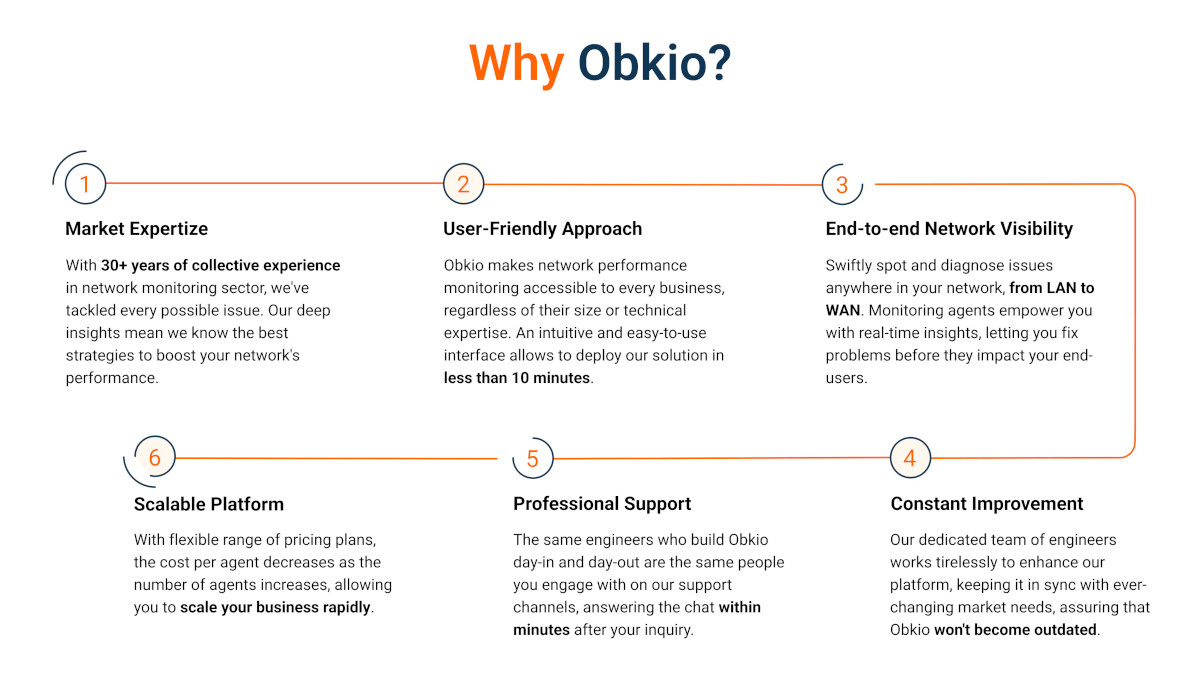



























 Obkio Blog
Obkio Blog






